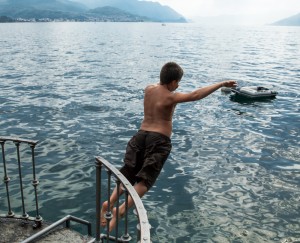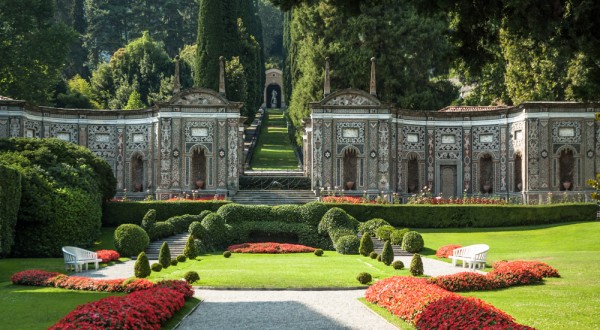Centuries of travelers have fallen for the lure of the lakes: the beautiful alpine lakes of northern Italy: Maggiore, Lugano, Como. Cyclists have a ringside seat to the sights and scents. See the Celebration Traveler Guide Cycling holidays: Italy for the day-by-day itinerary.
by Donna Peck
 Italy last summer was a sweet restorative. Seven days, three lakes, a bike and a paved surface. Does a cycling vacation get any simpler? On cool mornings, I raced side-by-side with the local cyclists, whizzing pass grocers unpacking lemons, housewives hanging laundry and cats stretching in the sun.
Italy last summer was a sweet restorative. Seven days, three lakes, a bike and a paved surface. Does a cycling vacation get any simpler? On cool mornings, I raced side-by-side with the local cyclists, whizzing pass grocers unpacking lemons, housewives hanging laundry and cats stretching in the sun.
Cycling is a popular sport and Italians pedal with athletic grace, barely breaking a sweat. “Salve,” we called to each other.
Our guide marked each day’s route on the pavement, so we felt like we belonged. Okay, we weren’t wearing Santini Maglificio Sportivo jerseys but we pedaled the route with assurance.
As healthy as it is to have toned thighs and calves, bike tourists covet most the ringside seat to a new culture.
Lead with your senses
Happenings are close at hand. In Lugano, the Swiss Italians rose early the morning to sweep the sidewalks and hang flags from balconies. They stopped to exchange pleasantries. “Is your son marching in the parade today?” was one greeting, referring to the Swiss National Day celebration. “Of course.” The marching bands and hand-waving politicians swept by as we pedaled out of Lugano.
Your senses pull you, let’s say, to the smell from the Alprose Chocolate Factory. On a bike, it’s easy to respond. Chocolate, as is widely publicized, makes people leaner, healthier and faster. The guide revealed during the factory tour that the Zurich council in 1722 banned chocolate drinks as aphrodisiacs and “unfit for virtuous citizens.” In the shop, we hung out at Free degustation bins. After swooning over dark chocolate with hazelnuts and almonds, and lingering at white chocolate filled with strawberry-mascarpone, we found ourselves at milk chocolate filled with latte-macchiato completed sated. We backtracked to the arrows and pedaled on.
 In the afternoons, our fitness high faded into the simple pleasure of cooling off: swimming in Lake Maggiore, eating pistachio gelato at the ferry, catching the spray from Lugano’s ornate fountains.
In the afternoons, our fitness high faded into the simple pleasure of cooling off: swimming in Lake Maggiore, eating pistachio gelato at the ferry, catching the spray from Lugano’s ornate fountains.
Decamp to the villa
Mid-week, a day out of the saddle arrives. As bike tourists, we are kin to the humans who centuries before us decamped to the foothills of the southern Alps. Pliny the Younger built his villa Tragedia on Lake Como in Bellagio where Villa Serbelloni now stands. In 1568 a wealthy cardinal built Villa d’Este on Cernobbio’s shores. A luxury hotel since 1873, its parkland and gardens retain vestiges of past ownership.
In 1568 a wealthy cardinal built Villa d’Este on Cernobbio’s shores. A luxury hotel since 1873, its parkland and gardens retain vestiges of past ownership.
Beyond the rose garden and Renaissance mosaic lies the Viale dell ’Ercole dedicated to Hercules, the paragon of masculinity in classical mythology. An avenue of Italian cypress and water-filled staircase directed our gaze to a marble sculpture crowning the hillock. Hercules, poisoned and wracked with pain, is about to hurl the messenger Lichus out to sea.
“In a savage fury Hercules cried out, ‘Was it you, Lichas, brought this fatal gift? Shall you be called the author of my death?’ ” wrote Sophocles, whose words may have inspired the piece. Hercules put on the tunic that his wife had smeared with poison deceived into thinking it was a love potion. Rescued from his funeral pyre and brought to Mount Olympus, Hercules received the mantle of immortality, for the gods deemed him worthy of a much better gift.
 Heroic exploits are also a popular theme in Villa d’Este’s wild places. A narrow staircase cut into the rocky hillside led us onto the upper trail. Half-hidden from below, it led to narrow bridges and dark tunnels, a fortress overgrown with vines. In 1808, a past owner ordered these mock fortifications constructed after her husband returned from the Napoleonic Wars. The trail brought us to a rapturous overlook of Lake Como.
Heroic exploits are also a popular theme in Villa d’Este’s wild places. A narrow staircase cut into the rocky hillside led us onto the upper trail. Half-hidden from below, it led to narrow bridges and dark tunnels, a fortress overgrown with vines. In 1808, a past owner ordered these mock fortifications constructed after her husband returned from the Napoleonic Wars. The trail brought us to a rapturous overlook of Lake Como.
The Medieval finale
After a few days of pumping up and down rolling shoreline, the final day’s route turned inland. I hit a mid-day lull and longed for a lakeside hotel, a refreshing plunge and lawn chair. This vision had materialized on previous arrivals but today, a grand finale had been promised.
 The vision held through a long climb past apple orchards, rustic farms and small villas. Sweat stinging my eyes, I gazed up in wonder at the red-tile roofs, bell towers and ramparts of medieval Bergamo. I felt like a soldier coming home from the campaigns: worn, weary and battle-scarred.
The vision held through a long climb past apple orchards, rustic farms and small villas. Sweat stinging my eyes, I gazed up in wonder at the red-tile roofs, bell towers and ramparts of medieval Bergamo. I felt like a soldier coming home from the campaigns: worn, weary and battle-scarred.
My bike wheels bouncing over slick cobblestones, I followed chalked arrows through the city gate and into the throngs heading toward the Plaza Vecchio. In one corner, the Bergamo museum immediately drew my attention. It housed an archeological excavation of the foundations of the Celtic city of Bergham visible below the plexiglass floor.
At some point, it registered that arrows wouldn’t guide me to the Gombit Hotel. I fell back on the Italian lesson from day one. “During the day until about 3 p.m., say “Buon Giorno” when greeting people. After 3 p.m., use “Buona Sera.”
Okay. “Buona Sera, can you tell me how to get to l’Hotel Gombit?” No help there, they were day trippers, had parked in the lower town and ridden the funicular up. I looked around again for someone who was not carrying a camera. A hand shot up from the sea of tables at Caffe de Tasso. I recognized John wearing the bike company’s yellow and green jersey.
He had already checked and was refueling over a macchiato and polenta petit fours. A retired doctor from Colorado, John rode fast and arrived first. He deposited me at the hotel then hopped on his bike. “Enough time before dinner for a few more miles,” he said. He was tracking his stats. He had a biker’s equivalent of the ten labors of Hercules to complete before the end of the tour.
I surrendered to a sweet interlude, a gelato on a park bench with my buddies Carol, Bill, Julie and Lisa. We joined the others for dinner, returning to Plaza Vecchio. The daytrippers had departed on the last funicular and the townspeople settled around the fountain, their voices mingling in the evening air. “Buona notte, ragazzi,” I heard around 11 p.m. As we turned toward the hotel, I already missed the arrows. Most of all, I missed not knowing where they would lead.
Lisa, the tour leader, said that when she returns each year and goes out to chalk the route, she finds arrows remaining from the previous summer. Weathered but not erased. Each year the arrows become more permanent. Our arrows had become part of the local lore and landscape.






Leave a Reply